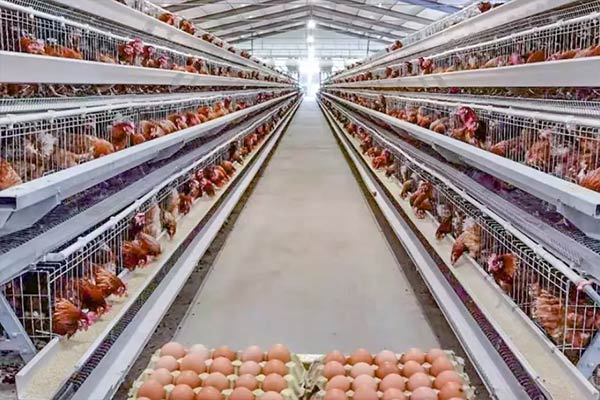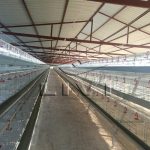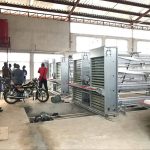In Uganda, poultry farming is a thriving industry, with layer chickens being a popular choice among farmers due to their high return on investment. Whether you’re a seasoned poultry farmer or a newcomer to the industry, finding the right battery cages for15,000 layer chickens is crucial for optimizing your farm’s productivity and ensuring the well-being of your birds.

Understanding Battery Cages
Battery cages are specialized enclosures designed to house layer chickens in a controlled environment, maximizing space and efficiency. They come in two main types: A-type and H-type battery cage, each offering distinct advantages depending on the scale and automation level of your poultry operation.
A-Type Battery Cages
- Structure: Simple and easy to maintain, making them ideal for medium-sized farms.
- Cost: Generally more affordable than H-type cages.
- Automation: Can be equipped with semi-automatic features for feeding, watering, and egg collection.
- Suitability: Best for farms with a moderate number of chickens, typically up to 15,000.
H-Type Battery Cages
- Structure: More complex, offering higher space utilization.
- Cost: Higher initial investment but reduces long-term labor costs.
- Automation: Fully automated systems for feeding, watering, egg collection, and manure removal.
- Suitability: Ideal for large-scale operations, housing upwards of 30,000 birds efficiently.

Benefits of Using Battery Cages
- Increased Productivity: Battery cages allow for a higher density of chickens per square meter, leading to increased egg production.
- Improved Hygiene: Automatic manure removal systems reduce the risk of disease by minimizing contact between chickens and their waste.
- Efficient Egg Collection: Eggs are collected automatically, reducing labor costs and minimizing egg breakage.
- Controlled Environment: Temperature and humidity can be regulated, providing optimal living conditions for the chickens.
Choosing the Right Battery Cage Supplier in Uganda
Selecting a reliable supplier is crucial for ensuring the quality and durability of your battery cages. Here are some key factors to consider:
- Material Quality: Opt for cages made from anti-corrosive materials to ensure longevity.
- Supplier Reputation: Choose suppliers with a proven track record in Uganda, such as Livi Machinery, known for their advanced technology and customer-centric services.
- Customization Options: Ensure the supplier can tailor the cage systems to your specific needs, including the size and automation level.
- Technical Support: Look for suppliers that offer installation guidance and ongoing technical support.

Case Studies: Successful Battery Cage Installations in Uganda
- 10,000 Birds Farm in Kampala: This farm uses semi-automatic A-type cages, allowing for manual feeding and egg collection. The owner expanded the farm with automated feeding trolleys for efficiency.
- 25,000 Birds Poultry Farm: Equipped with full automation, this farm operates with minimal labor, using H-type cages, automated feeders, and manure removal systems. Despite the higher initial investment, the farm benefits from reduced labor costs and increased productivity.
Cost of Battery Cage
The price of battery cages in Uganda varies based on type, automation level, and supplier. Here is a rough price range based on current market data:
- A-Type Cages: Approximately $100 to $180 per set.
- H-Type Cages: Approximately $200 to $300 per set.
It’s essential to balance cost with quality and features to ensure a sustainable investment.

Steps to Acquire Battery Cages in Uganda
- Assess Your Needs: Determine the number of chickens, desired automation level, and budget.
- Research Suppliers: Compare offerings from reputable suppliers, focusing on quality and customer reviews.
- Request Proposals: Contact suppliers for detailed proposals, including pricing, cage specifications, and installation services.
- Evaluate Proposals: Consider the total cost, including shipping and installation, and choose the best option for your farm.
- Installation and Setup: Work with the supplier to ensure proper installation and setup of the cages.
Conclusion
Investing in the right battery cages for your layer chickens is a critical step towards a successful poultry farming operation in Uganda. By understanding the options available and selecting a reputable supplier, you can enhance your farm’s productivity, reduce labor costs, and ensure the health and welfare of your chickens. Whether you opt for A-type or H-type cages, prioritize quality, and automation features that align with your farm’s goals.
For more information or to explore battery cage options, contact leading suppliers like Livi Machinery, who offer comprehensive solutions tailored to Ugandan poultry farms. Take the next step in optimizing your poultry farming business and reap the benefits of increased efficiency and profitability.






